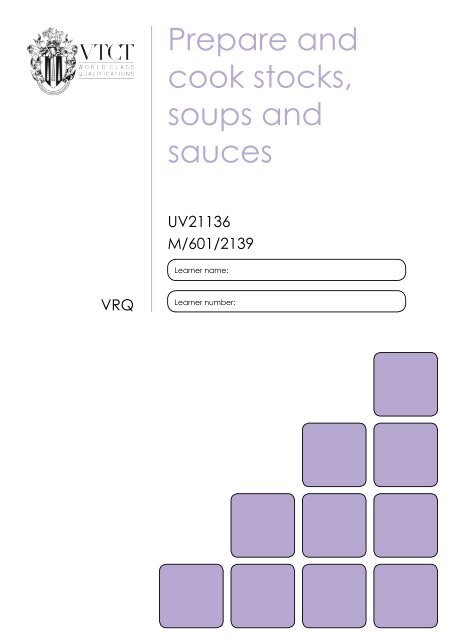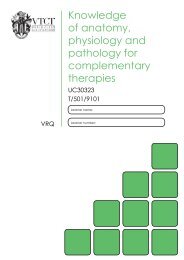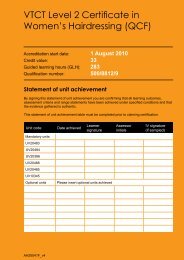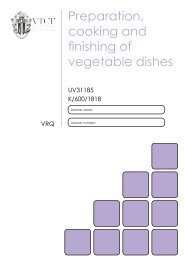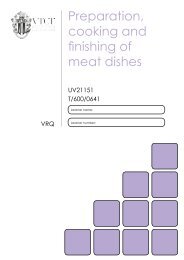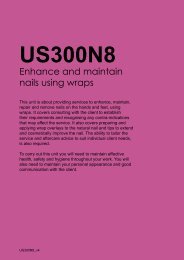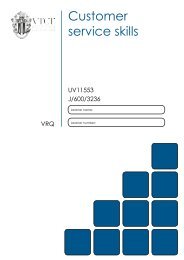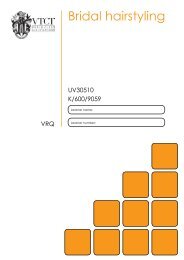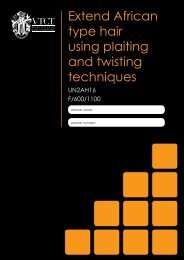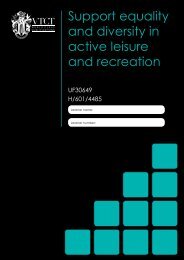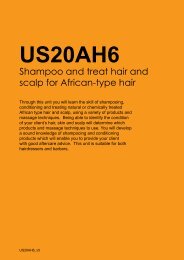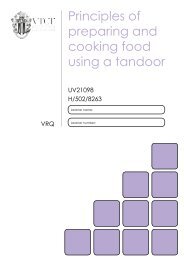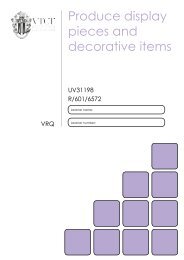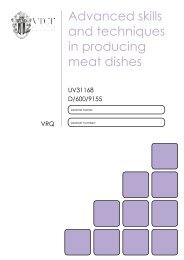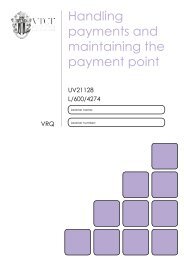Prepare and cook stocks, soups and sauces - VTCT
Prepare and cook stocks, soups and sauces - VTCT
Prepare and cook stocks, soups and sauces - VTCT
You also want an ePaper? Increase the reach of your titles
YUMPU automatically turns print PDFs into web optimized ePapers that Google loves.
VRQ<br />
<strong>Prepare</strong> <strong>and</strong><br />
<strong>cook</strong> <strong>stocks</strong>,<br />
<strong>soups</strong> <strong>and</strong><br />
<strong>sauces</strong><br />
UV21136<br />
M/601/2139<br />
Learner name:<br />
Learner number:
Statement of unit achievement<br />
By signing this statement of unit achievement you are confirming that all learning outcomes, assessment<br />
criteria <strong>and</strong> range statements have been achieved under specified conditions <strong>and</strong> that the evidence<br />
gathered is authentic.<br />
This statement of unit achievement table must be completed prior to claiming certification.<br />
Unit code Date achieved Learner signature<br />
Assessor tracking table<br />
<strong>VTCT</strong> is the specialist awarding body for the Hairdressing, Beauty Therapy, Complementary Therapy,<br />
Hospitality <strong>and</strong> Catering <strong>and</strong> Sport <strong>and</strong> Active Leisure sectors, with over 45 years of experience.<br />
<strong>VTCT</strong> is an awarding body regulated by national organisations including Ofqual, SQA, DfES <strong>and</strong> CCEA.<br />
<strong>VTCT</strong> is a registered charity investing in education <strong>and</strong> skills but also giving to good causes in the area<br />
of facial disfigurement.<br />
Assessor name Assessor signature<br />
Assessor<br />
initials<br />
Assessors<br />
initials<br />
IV signature<br />
(if sampled)<br />
All assessors using this Record of Assessment book must complete this table. This is required for<br />
verification purposes.<br />
Assessor number<br />
(optional)
UV21136<br />
<strong>Prepare</strong> <strong>and</strong> <strong>cook</strong> <strong>stocks</strong>, <strong>soups</strong><br />
<strong>and</strong> <strong>sauces</strong><br />
The aim of this unit is to develop your knowledge,<br />
underst<strong>and</strong>ing <strong>and</strong> practical skills in preparing <strong>and</strong> <strong>cook</strong>ing<br />
<strong>stocks</strong>, <strong>soups</strong> <strong>and</strong> <strong>sauces</strong>. You will study their quality points<br />
<strong>and</strong> storage requirements.<br />
You will demonstrate how to make a range of different<br />
<strong>soups</strong> which are always a popular menu item, so it is<br />
important that they are prepared to a high st<strong>and</strong>ard.<br />
You will also be preparing <strong>and</strong> <strong>cook</strong>ing <strong>stocks</strong> <strong>and</strong> <strong>sauces</strong><br />
which are important in the kitchen because of the way they<br />
enhance <strong>and</strong> complement the flavour of foods.<br />
UV21136_v5
Level<br />
Credit value<br />
GLH<br />
2<br />
6<br />
40<br />
Observation(s)<br />
2<br />
External paper(s)<br />
0
<strong>Prepare</strong> <strong>and</strong> <strong>cook</strong> <strong>stocks</strong>, <strong>soups</strong><br />
<strong>and</strong> <strong>sauces</strong><br />
Learning outcomes<br />
On completion of this unit you will:<br />
1. Be able to prepare <strong>and</strong> <strong>cook</strong> <strong>stocks</strong><br />
2. Be able to prepare <strong>and</strong> <strong>cook</strong> <strong>soups</strong><br />
3. Be able to prepare <strong>and</strong> <strong>cook</strong> <strong>sauces</strong><br />
Evidence requirements<br />
1. Environment<br />
Evidence for this unit may be gathered<br />
within the workplace or realistic working<br />
environment (RWE).<br />
2. Simulation<br />
Simulation may be used in this unit, where<br />
no naturally occurring evidence is available.<br />
3. Observation outcomes<br />
Competent performance of Observation<br />
outcomes must be demonstrated on<br />
at least two occasions. Assessor<br />
observations, witness testimonies <strong>and</strong><br />
products of work are likely to be the most<br />
appropriate sources of performance<br />
evidence. Professional discussion may be<br />
used as supplementary evidence for those<br />
criteria that do not naturally occur.<br />
Assessed observations should not be<br />
carried out on the same day for the<br />
same learning outcome. There should be<br />
sufficient time between assessments for<br />
reflection <strong>and</strong> personal development.<br />
You need to meet the same st<strong>and</strong>ard on a<br />
regular <strong>and</strong> consistent basis. Separating<br />
the assessments by a period of at least two<br />
weeks is recommended as competence<br />
must be demonstrated on a consistent <strong>and</strong><br />
regular basis.<br />
4. Range<br />
All ranges must be practically demonstrated<br />
or other forms of evidence produced to<br />
show they have been covered.<br />
5. Knowledge outcomes<br />
There must be evidence that you possess<br />
all the knowledge <strong>and</strong> underst<strong>and</strong>ing<br />
listed in the Knowledge section of this<br />
unit. In most cases this can be done<br />
by professional discussion <strong>and</strong>/or oral<br />
questioning. Other methods, such as<br />
projects, assignments <strong>and</strong>/or reflective<br />
accounts may also be used.<br />
6. Tutor/Assessor guidance<br />
You will be guided by your tutor/assessor<br />
on how to achieve learning outcomes <strong>and</strong><br />
cover ranges in this unit. All outcomes <strong>and</strong><br />
ranges must be achieved.<br />
7. External paper<br />
There is no external paper requirement for<br />
this unit.<br />
UV21136<br />
3
4<br />
Achieving observations<br />
<strong>and</strong> range<br />
Achieving observation outcomes Achieving range<br />
Your assessor will observe your performance<br />
of practical tasks. The minimum number of<br />
competent observations required is indicated in<br />
the Evidence requirements section of this unit.<br />
Criteria may not always naturally occur during<br />
a practical observation. In such instances you<br />
will be asked questions to demonstrate your<br />
competence in this area. Your assessor will<br />
document the criteria that have been achieved<br />
through professional discussion <strong>and</strong>/or oral<br />
questioning. This evidence will be recorded<br />
by your assessor in written form or by other<br />
appropriate means.<br />
Your assessor will sign off a learning outcome<br />
when all criteria have been competently<br />
achieved.<br />
UV21136<br />
The range section indicates what must<br />
be covered. Ranges should be practically<br />
demonstrated as part of an observation. Where<br />
this is not possible other forms of evidence may<br />
be produced. All ranges must be covered.<br />
Your assessor will document the portfolio<br />
reference once a range has been competently<br />
achieved.
Learning outcome 1<br />
Be able to prepare <strong>and</strong> <strong>cook</strong> <strong>stocks</strong><br />
You can:<br />
a. Demonstrate the correct use of equipment<br />
to prepare, <strong>cook</strong> <strong>and</strong> store <strong>stocks</strong><br />
b. <strong>Prepare</strong> ingredients for making <strong>stocks</strong><br />
c. Cook different types of <strong>stocks</strong> (fresh)<br />
d. Apply quality points to each stage of the<br />
process<br />
e. Demonstrate safe <strong>and</strong> hygienic practices*<br />
*May be assessed by supplementary evidence.<br />
Observations<br />
Observation 1 2 Optional Optional<br />
Criteria questioned orally<br />
Date achieved<br />
Portfolio reference<br />
Learner signature<br />
Assessor initials<br />
UV21136<br />
5
6<br />
Learning outcome 2<br />
Be able to prepare <strong>and</strong> <strong>cook</strong> <strong>soups</strong><br />
You can:<br />
a. Demonstrate the correct use of equipment<br />
to prepare, <strong>cook</strong> <strong>and</strong> store <strong>soups</strong><br />
b. <strong>Prepare</strong> ingredients for making soup,<br />
according to recipe or dish requirements<br />
c. Cook different types of soup<br />
d. Demonstrate finishing methods <strong>and</strong> present<br />
with appropriate accompaniments<br />
e. Apply quality points to each stage of the<br />
process<br />
f. Demonstrate safe <strong>and</strong> hygienic practices*<br />
*May be assessed by supplementary evidence.<br />
Observation 1 2 Optional Optional<br />
Criteria questioned orally<br />
Date achieved<br />
Portfolio reference<br />
Learner signature<br />
Assessor initials<br />
UV21136
Learning outcome 3<br />
Be able to prepare <strong>and</strong> <strong>cook</strong> <strong>sauces</strong><br />
You can:<br />
a. Demonstrate the correct use of equipment<br />
to prepare, <strong>cook</strong> <strong>and</strong> store <strong>sauces</strong><br />
b. <strong>Prepare</strong> ingredients for making <strong>sauces</strong>,<br />
according to recipe <strong>and</strong> dish requirements<br />
c. Produce different types of <strong>sauces</strong><br />
d. Demonstrate finishing methods<br />
e. Apply quality points to each stage of the<br />
process<br />
f. Demonstrate safe <strong>and</strong> hygienic practices*<br />
*May be assessed by supplementary evidence.<br />
Observation 1 2 Optional Optional<br />
Criteria questioned orally<br />
Date achieved<br />
Portfolio reference<br />
Learner signature<br />
Assessor initials<br />
UV21136<br />
7
8<br />
Range<br />
You must practically demonstrate that you have:<br />
<strong>Prepare</strong>d a minimum of 2 types of stock Portfolio reference<br />
White<br />
Brown<br />
Fish<br />
Vegetable<br />
<strong>Prepare</strong>d <strong>and</strong> <strong>cook</strong>ed a minimum of 4 types of soup Portfolio reference<br />
Consommé<br />
Potage<br />
Purée<br />
Cream<br />
Velouté<br />
Bisque<br />
Chilled<br />
Used a minimum of 4 finishing accompaniments Portfolio reference<br />
Cream<br />
Garnish<br />
Herbs<br />
Butter<br />
Liaison<br />
Croutons or flutes<br />
Cheese<br />
It is strongly recommended that all range items are practically demonstrated. Where this is not<br />
possible, other forms of evidence may be produced to demonstrate competence.<br />
UV21136
You must practically demonstrate that you have:<br />
<strong>Prepare</strong>d <strong>and</strong> <strong>cook</strong>ed a minimum of 4 types of <strong>sauces</strong> Portfolio reference<br />
Roast gravy<br />
Béchamel (including derivatives)<br />
Jus lié (including derivatives)<br />
Purée<br />
Reduction<br />
Tomato<br />
It is strongly recommended that all range items are practically demonstrated. Where this is not<br />
possible, other forms of evidence may be produced to demonstrate competence.<br />
UV21136 9
10<br />
Developing knowledge<br />
Achieving knowledge outcomes<br />
You will be guided by your tutor <strong>and</strong> assessor<br />
on the evidence that needs to be produced.<br />
Your knowledge <strong>and</strong> underst<strong>and</strong>ing will be<br />
assessed using the assessment methods listed<br />
below*:<br />
• Projects<br />
• Observed work<br />
• Witness statements<br />
• Audio-visual media<br />
• Evidence of prior learning or attainment<br />
• Written questions<br />
• Oral questions<br />
• Assignments<br />
• Case studies<br />
• Professional discussion<br />
Where applicable your assessor will integrate<br />
knowledge outcomes into practical observations<br />
through professional discussion <strong>and</strong>/or oral<br />
questioning.<br />
When a criterion has been orally questioned<br />
<strong>and</strong> achieved, your assessor will record this<br />
evidence in written form or by other appropriate<br />
means. There is no need for you to produce<br />
additional evidence as this criterion has already<br />
been achieved.<br />
Some knowledge <strong>and</strong> underst<strong>and</strong>ing outcomes<br />
may require you to show that you know <strong>and</strong><br />
underst<strong>and</strong> how to do something. If you have<br />
practical evidence from your own work that<br />
meets knowledge criteria, then there is no<br />
requirement for you to be questioned again on<br />
the same topic.<br />
*This is not an exhaustive list.<br />
UV21136
Knowledge<br />
Learning outcome 1<br />
Be able to prepare <strong>and</strong> <strong>cook</strong> <strong>stocks</strong><br />
You can: Portfolio reference<br />
f. Evaluate the finished product<br />
g. Identify different types of stock<br />
h. State the uses of stock<br />
i. Explain the quality points in preparing <strong>and</strong> <strong>cook</strong>ing <strong>stocks</strong><br />
j. Identify the preparation principles for <strong>stocks</strong><br />
k. Explain why different <strong>stocks</strong> require different <strong>cook</strong>ing times<br />
l. State the <strong>cook</strong>ing times of different <strong>stocks</strong><br />
m. Identify the <strong>cook</strong>ing <strong>and</strong> chilling principles for <strong>stocks</strong><br />
n. Identify correct storage procedures for <strong>stocks</strong><br />
UV21136 11
12<br />
Learning outcome 2<br />
Be able to prepare <strong>and</strong> <strong>cook</strong> <strong>soups</strong><br />
You can: Portfolio reference<br />
g. Evaluate the finished product<br />
h. Identify the different types of soup<br />
i. Explain the quality points in preparing <strong>and</strong> <strong>cook</strong>ing <strong>soups</strong><br />
j. Identify preparation <strong>and</strong> <strong>cook</strong>ing principles for <strong>soups</strong><br />
k. Identify appropriate finishing methods <strong>and</strong> accompaniments for<br />
<strong>soups</strong><br />
UV21136
Learning outcome 3<br />
Be able to prepare <strong>and</strong> <strong>cook</strong> <strong>sauces</strong><br />
You can: Portfolio reference<br />
g. Evaluate the finished product<br />
h. Identify different types of <strong>sauces</strong><br />
i. Identify sauce <strong>and</strong> dish combinations<br />
j. Explain the purpose of <strong>sauces</strong><br />
k. Explain the quality points in preparing <strong>and</strong> <strong>cook</strong>ing <strong>sauces</strong><br />
l. Identify the preparation/<strong>cook</strong>ing principles for <strong>sauces</strong><br />
m. Describe the skills needed to check <strong>and</strong> finish <strong>sauces</strong><br />
n. Identify correct storage procedures for <strong>sauces</strong><br />
UV21136 13
14<br />
Unit content<br />
This section provides guidance on the recommended knowledge <strong>and</strong> skills required to enable you<br />
to achieve each of the learning outcomes in this unit. Your tutor/assessor will ensure you have the<br />
opportunity to cover all of the unit content.<br />
Outcome 1: Be able to prepare <strong>and</strong> <strong>cook</strong> <strong>stocks</strong><br />
Equipment: Coloured coded boards,<br />
knives, stock pot, strainers, pans, storage<br />
containers, refrigerator, stove.<br />
Types of stock: White (beef, chicken),<br />
brown (beef, chicken, veal), fish,<br />
vegetable.<br />
<strong>Prepare</strong> ingredients: Blanching,<br />
browning, bones, vegetables (mirepoix),<br />
herbs.<br />
Quality points: Freshness, colour, clarity,<br />
free from fat, taste, aroma.<br />
Safe <strong>and</strong> hygienic practices: Appropriate<br />
protective clothing, wash h<strong>and</strong>s regularly,<br />
clean <strong>and</strong> clear working area <strong>and</strong> tools.<br />
Evaluate the finished product: Colour,<br />
clarity, flavour, aroma, seasoning.<br />
Uses of stock: Soups, <strong>sauces</strong>, <strong>cook</strong>ing<br />
liquor.<br />
Preparation principles: Blanching,<br />
browning.<br />
Reasons for different <strong>cook</strong>ing times:<br />
Flavour, collagen content, bones used.<br />
Cooking times for different <strong>stocks</strong>: Fish<br />
30-40 minutes, chicken 3-4 hours, meat 5-8<br />
hours, vegetables 30 minutes.<br />
Cooking <strong>and</strong> chilling principles:<br />
Simmering, skimming, reducing, blast<br />
chilling to below 5ºC.<br />
Storage procedures: Below 5ºC, label<br />
with date, stock rotation.<br />
UV21136
Outcome 2: Be able to prepare <strong>and</strong> <strong>cook</strong> <strong>soups</strong><br />
Equipment: Pans, stove, spoons, knives,<br />
coloured coded boards, strainers, ladles.<br />
<strong>Prepare</strong> ingredients: Cutting (meat,<br />
vegetables), adding stock.<br />
Different types of soup: Consommé,<br />
potage (broth), purée, cream, velouté,<br />
bisque, chilled.<br />
Finishing methods <strong>and</strong><br />
accompaniments: Cream, garnish, herbs,<br />
butter, liaison, croutons, flutes, cheese.<br />
Quality points: Freshness, colour,<br />
consistency, temperature, appearance,<br />
taste, aroma.<br />
Safe <strong>and</strong> hygienic practices: Appropriate<br />
protective clothing, wash h<strong>and</strong>s regularly,<br />
clean <strong>and</strong> clear working area <strong>and</strong> tools.<br />
Evaluate the finished product: Colour,<br />
clarity, flavour, aroma, seasoning.<br />
Preparation <strong>and</strong> <strong>cook</strong>ing principles:<br />
Cutting (meat, vegetables), sweating,<br />
simmering, skimming, blending, straining.<br />
UV21136 15
16<br />
Outcome 3: Be able to prepare <strong>and</strong> <strong>cook</strong> <strong>sauces</strong><br />
Equipment: Pans, stove, spoons, knives,<br />
coloured coded boards, strainers, ladles.<br />
<strong>Prepare</strong> ingredients: Cutting (meat,<br />
vegetables), adding stock.<br />
Types of <strong>sauces</strong>: Roast gravy, béchamel<br />
derivatives, jus lié derivatives, purée,<br />
reductions, tomato.<br />
Finishing methods: Skimming, correct<br />
seasoning, check flavour.<br />
Quality points: Freshness, colour,<br />
consistency, appearance, taste, aroma,<br />
shine.<br />
Safe <strong>and</strong> hygienic practices: Appropriate<br />
protective clothing, wash h<strong>and</strong>s regularly,<br />
clean <strong>and</strong> clear working area <strong>and</strong> tools.<br />
Evaluate the finished product: Colour,<br />
flavour, aroma, seasoning, shine.<br />
Sauce <strong>and</strong> dish combinations: Roast<br />
meats (roast gravy), fish (reductions,<br />
batter, tartar, tomato), eggs (béchamel<br />
derivatives).<br />
Purpose of <strong>sauces</strong>: Enhance flavour,<br />
complement taste, improve digestion,<br />
customer expectations.<br />
Preparation <strong>and</strong> <strong>cook</strong>ing principles:<br />
Cutting (meat, vegetables), adding stock,<br />
reducing, thickening (roux, liaison, cream,<br />
butter), simmering, skimming.<br />
Skills needed to check <strong>and</strong> finish<br />
<strong>sauces</strong>: Adjust consistency (thickening),<br />
adjust flavouring, correct seasoning, check<br />
temperature.<br />
Storage procedures for <strong>sauces</strong>: Below<br />
5ºC, label with date, stock rotation.<br />
UV21136


